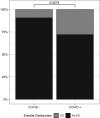"Mask up to keep it up": Preliminary evidence of the association between erectile dysfunction and COVID-19
- PMID: 33742540
- PMCID: PMC8250520
- DOI: 10.1111/andr.13003
"Mask up to keep it up": Preliminary evidence of the association between erectile dysfunction and COVID-19
Abstract
Background: Erectile dysfunction (ED), as the hallmark of endothelial dysfunction, could be a short- or long-term complication of COVID-19. Additionally, being ED a clinical marker and predictor of non-communicable chronic diseases, particularly cardiovascular, subjects with ED could potentially have a higher risk of contracting COVID-19.
Objectives: To investigate the prevalence of ED among subjects with a reported diagnosis of COVID-19 and to measure the association of COVID-19 and ED.
Materials and methods: We reviewed data from the Sex@COVID online survey (performed between April 7 and May 4, 2020, in Italy) to retrieve a sample of Italian male sexually active subjects with reported SARS-CoV-2 infection. A matching sample of COVID-19-negative male sexually active subjects was also retrieved using propensity score matching in a 3:1 ratio. The survey used different standardized psychometric tools to measure effects of lockdown and social distancing on the intrapsychic, relational, and sexual health of Italian subjects.
Results: One hundred subjects were included in the analysis (25 COVID-positive; 75 COVID-negative). The prevalence of ED, measured with the Sexual Health Inventory for Men, was significantly higher in the COVID+ group (28% vs. 9.33%; p = 0.027). Logistic regression models confirmed a significant effect of COVID-19 on the development of ED, independently of other variables affecting erectile function, such as psychological status, age, and BMI [OR 5.66, 95% CI: 1.50-24.01]. Likewise, subjects with ED were more likely to have COVID-19, once corrected for age and BMI [OR 5.27, 95% CI: 1.49-20.09].
Discussion and conclusion: On top of well-described pathophysiological mechanisms, there is preliminary evidence in a real-life population of ED as a risk factor of developing COVID-19 and possibly occurring as a consequence of COVID-19. Universal vaccination against the COVID-19 and the personal protective equipment could possibly have the added benefit of preventing sexual dysfunctions.
Keywords: COVID-19; SARS-CoV-2; coronavirus; endothelial dysfunction; erectile dysfunction; testosterone.
© 2021 American Society of Andrology and European Academy of Andrology.
Conflict of interest statement
The authors declare no competing interests for the present study.
Figures
References
Publication types
MeSH terms
Grants and funding
LinkOut - more resources
Full Text Sources
Other Literature Sources
Medical
Miscellaneous


